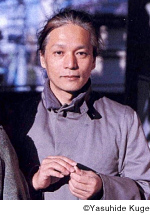Norimizu Ameya | Director/artist
 Born in 1961. In 1978 he joined one of the major troupes of the Underground Theatre Movement in Japan, Juro Kara’s Jokyo Gekijo, where he was in charge of the sound. In 1984 he formed the “Tokyo Grand Guignol”, rendering him cult popularity. In 1987, he founded [M.M.M.], a company working intensively on the relationship between mechanical apparatus and the human body. With the “SKIN” series, they established a cyberpunk scenic expression. After 1990 he left the field of theatre and began to engage himself with visual arts - still proceeding to work on his major topic - the human body - taking up themes like blood transfusion, artificial fertilization, infection disease, selective breeding, chemical food, and sex discrimination, creating works as a member of the collaboration unit Technocrat. After participating in the Venice Biennale with “Public Sperma” in 1995, he suspended his activities as a visual artist. The same year he opened a pet shop in Higashi-Nakano in Tokyo, breeding and selling various animals. In 1997 he published a book, “Do you know how to live with animals?” (the name was later changed to “Do you know how to live with rare animals?”, when it was printed in paperback), where he not only gives information on the distinctions of, and how to breed rare pets, but also reflects on the co-habitation of humans and animals, based on his own experiences. In 2005, he presented a performance in the exhibition “Vanishing Point”, which marked a restart of his activities in visual arts after a long break. This is a work in which he is locked up in a 1,8 meter large white box. With only a minimum of fresh air and a fluid diet he stayed inside the box for 24 days, where knocking on the walls was his sole communication with the outside world. The artist’s presence was the elementary component of the artwork. In 2007 he directed Oriza Hirata’s “Transfer Student” in the frame of the Shizuoka Performing Arts Center’s (SPAC) “SPAC autumn season 2007”, casting real high school students. The work was also shown at the Festival/Tokyo 09 Spring.
Born in 1961. In 1978 he joined one of the major troupes of the Underground Theatre Movement in Japan, Juro Kara’s Jokyo Gekijo, where he was in charge of the sound. In 1984 he formed the “Tokyo Grand Guignol”, rendering him cult popularity. In 1987, he founded [M.M.M.], a company working intensively on the relationship between mechanical apparatus and the human body. With the “SKIN” series, they established a cyberpunk scenic expression. After 1990 he left the field of theatre and began to engage himself with visual arts - still proceeding to work on his major topic - the human body - taking up themes like blood transfusion, artificial fertilization, infection disease, selective breeding, chemical food, and sex discrimination, creating works as a member of the collaboration unit Technocrat. After participating in the Venice Biennale with “Public Sperma” in 1995, he suspended his activities as a visual artist. The same year he opened a pet shop in Higashi-Nakano in Tokyo, breeding and selling various animals. In 1997 he published a book, “Do you know how to live with animals?” (the name was later changed to “Do you know how to live with rare animals?”, when it was printed in paperback), where he not only gives information on the distinctions of, and how to breed rare pets, but also reflects on the co-habitation of humans and animals, based on his own experiences. In 2005, he presented a performance in the exhibition “Vanishing Point”, which marked a restart of his activities in visual arts after a long break. This is a work in which he is locked up in a 1,8 meter large white box. With only a minimum of fresh air and a fluid diet he stayed inside the box for 24 days, where knocking on the walls was his sole communication with the outside world. The artist’s presence was the elementary component of the artwork. In 2007 he directed Oriza Hirata’s “Transfer Student” in the frame of the Shizuoka Performing Arts Center’s (SPAC) “SPAC autumn season 2007”, casting real high school students. The work was also shown at the Festival/Tokyo 09 Spring.




